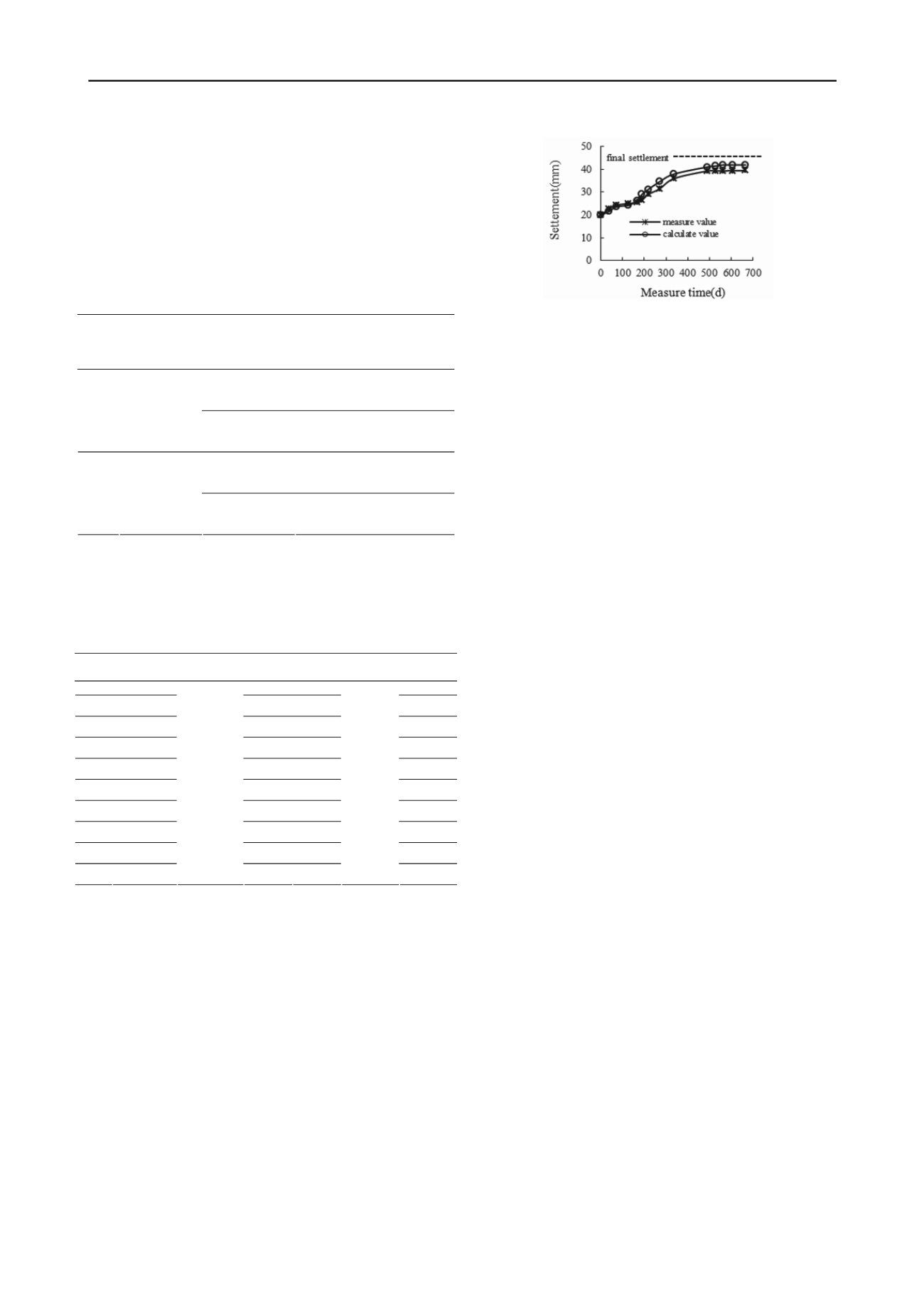
2876
Proceedings of the 18
th
International Conference on Soil Mechanics and Geotechnical Engineering, Paris 2013
4.2 Calculation of Recompression Deformation
Figure. 9 the developing curves of settlement from calculating and
measuring of main building
For this foundation pit, the estimating unloading stress is about
353.35kPa. For the main buildings, since the pressure under the
foundation is larger than unloading pressure, the settlement of
foundation soil includes both recompression deformation and
consolidation settlement. Recompression deformation can be
calculated as formula 2. Firstly the curves of reloading ratio-
recompression ratio of soil can be obtained by soil tests. By
analyzing the curves, the expression of reloading ratio-
recompression ratio can be determined and listed in table 2.
Table 2 The expression of reloading ratio and recompression ratio
NO.
Consolidation
Pressure
(
kPa)
Condition of
R
expression
0
0.125
R
1 1
r a b R
1
0.0541
a
1
2.8726
b
1-3
300
0.125
1.0
R
2 2
r a b R
1
0.5173
a
1
0.5643
b
0
0.125
R
1 1
r a b R
1
0.0264
a
1
3.551
b
1-4
400
0.125
1.0
R
2 2
r a b R
1
0.4206
a
1
0.6625
b
5 CONCLUSIONS
Through the soil test, model experiment and engineering
application, the conclusion of rebound and recompression
deformation can be summarized by the following clauses:
Estimate the reloading stress of each construction stage
according the construction progress to get the recompression
ratio of each stage. Then recompression deformation of each
stage can be calculated as table.3. When the reloading pressure
is equal to the unloading pressure, the compression deformation
is about 36.7mm.
(1) The dimensionless parameters such as rebound proportion,
reloading ratio, recompression ratio are proposed and used in
research, and the basic law of rebound deformation and
recompression deformation can be got, and then the calculation
methods of rebound deformation and recompression
deformation are put forward. Mathematical relation between
rebound and recompression deformation is established;
(2)
R
cr
can be determined by the curves of
R-E
c
, and the
calculation depth of rebound deformation can be calculated
according to
R
cr
.
E
c
must be determined by corresponding stress
state of soil and stress history. This method is not only
simplifying the process of calculation but also improving
accuracy.
Table 3 The calculating table of recompression deformation under main
building in each conditions
(3)The calculation method of recompression deformation
proposed by this paper can compute deformation of each
construction stage.
NO.
Reloading
kPa
Unloading
kPa
R
r
S
c
mm
S
;
c
mm
(1)
80.3
0.2272 0.5711
19.99
⑵
103.4
0.2926 0.6144
21.50
⑶
134.9
0.3818 0.6735
23.57
⑷
145.4
0.4115 0.6932
24.26
⑸
176.9
0.5006 0.7522
26.33
⑹
218.9
0.6195 0.8310
29.08
⑺
250.4
0.7086 0.8900
31.15
⑻
302.9
0.8572 0.9885
34.60
⑼
318.9
0.9025 1.0185
35.65
⑽
334.9
353.35
0.9478 1.0485
35.0
36.70
(4) In initial stage of construction, the reloading stress is low,
but the deformation is obvious. Meanwhile, the concrete
strength of foundation had not formed completely and the
superstructure had not constructed generally, so there is no
additional stress caused by the recompression deformation. It is
beneficial for the deformation control.
REFERENCES
1 LI Jianmin.2010.
Research on the calculation method of resilient
deformation in ultra-deep foundation pit
[D]. Beijing: china academy
of building research.
The consolidation settlement caused by additional stress is
calculated by the layer-wise summation method recommended
by Code for Design of Building Foundation
[7]
. By calculating,
the consolidation settlement is 10.24mm. So the final settlement
of the main building is 46.94 mm.
2 TENG Yanjing, LI Jianmin. 2011.
Research on the analyzing and
calculation method of resilient deformation in ultra-deep foundation
pit
[R]. Beijing: china academy of building research.
3 LI Jianmin, TENG yanjing. 2010.Model test on rebound deformation
in foundation pit excavation.
Chinese Journal of Geotechnical
Engineering
, 32(S2): 81-84.
Usually the settlement of foundation is observed after raft
foundation construction, and observation points are set on the
raft foundation, so the recompression caused by gravity of raft
foundation can’t be monitored. According to the basic law of
recompression deformation, the recompression deformation
cannot be ignored, when reloading stress is low. The
recompression deformation caused by gravity of raft foundation
can be calculated as No. (1) in table 3. In this stage of
construction, since the concrete strength of foundation had not
formed completely and the superstructure had not constructed
generally, there is no additional stress caused by the
recompression deformation.
4 LI Jianmin, TENG Yanjing. 2011.Reaching for the character of
rebound deformation of foundation pit excavation by compression
and resilience test of different sorts of soil[J].
Building Science
, 27(1):
72-77.
5 LI Jianmin, TENG Yanjing.2010. Experimental study on the
characteristics of the rebound and the recompression deformation of
soil under unloading.
Geotechnical Investigation & Surveying
,
38(12): 9-14.
6 LI Jianmin, TENG Yanjing.2011. Test study of law of recompression
deformation of soil[J]
Rock and Soil Mechanics
, 32(S2): 463-468.
The settlement curves of calculation and observation of the
main building
are shown as Figure 9, and the line of dashes
shows the calculated final settlement.
Both the calculated
settlement and monitored settlement have the same
development tendency, but the calculated settlement is little
higher than the corresponding one monitored.
7 National Standard of the People’s Republic of China.2011.
GB50007
—
2011 Code for design of building foundation. Beijing:
China Architecture and Building Press, (in Chinese).


